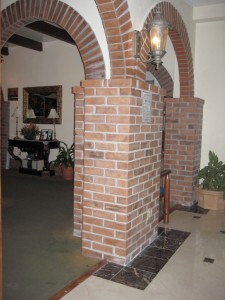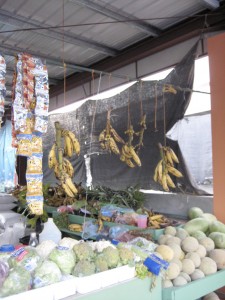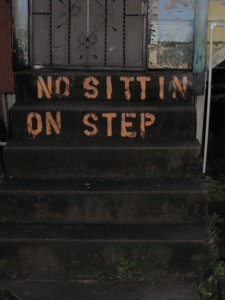Archive for July, 2008
Design Missteps
 The main brick column here is about 6 feet tall. I assumed that the top of it was closed off, so I set my wallet and two sets of keys on it, which promptly fell into a crevice. It took the hotel staff about 30 minutes to help me fish out my belongings with wire hangers. The builder of the building happened to be eating dinner at a table about 10 feet from the column during the event.
The main brick column here is about 6 feet tall. I assumed that the top of it was closed off, so I set my wallet and two sets of keys on it, which promptly fell into a crevice. It took the hotel staff about 30 minutes to help me fish out my belongings with wire hangers. The builder of the building happened to be eating dinner at a table about 10 feet from the column during the event.
–
The San Ignacio market has about 10 vendors on weekdays, but on Saturdays the market area is flooded with a huge number of merchants. In the last year, a new, large structure was built for the market to house the everyday vendors and a new concrete slab was laid for the weekend merchants to set up temporary tents on.

 I think it’s great that there is investment being put into infrastructure for something so obviously important to the local economy, but I think there are a few major oversights in the design of the site. The most major one is that the majority of the vendors are on a north-south axis and the east to west brightly shining sun blasts in on the vendors and their products essentially all day every day. To deal with this, all of the vendors have strung up tarps or sheets to block out the sun.
I think it’s great that there is investment being put into infrastructure for something so obviously important to the local economy, but I think there are a few major oversights in the design of the site. The most major one is that the majority of the vendors are on a north-south axis and the east to west brightly shining sun blasts in on the vendors and their products essentially all day every day. To deal with this, all of the vendors have strung up tarps or sheets to block out the sun.
Additionally, the design of the stalls just doesn’t seem to consider what will happen in them. Every stall has added a system of ropes and pipes to hang bananas and other good off for selling. They are making the most of their space, but the design of the stall could have anticipated and assisted in this and other produce selling needs.
Also:
Belizean Service Norms: Napkin Wrapping
The standard way to serve silverware, either metal or plastic, at a restaurant or take away is wrapped in a paper napkin:
Beers and sodas in glass bottles are always served with a napkin on top of the bottle:
BarCamp Nairobi
BarCamp Nairobi was a “unconference” held 21 June 2008, where bloggers, programmers, and other techy folk in and around Nairobi met up to “share and learn in an open environment”.
White African has a few videos from the event.
O’reilly had a survey carried out at BarCamp with the following results:


“Anthropology’s Technology-driven Renaissance”
Anthropology’s Technology-driven Renaissance, a article for PC World by Ken Banks of kiwanja.net, emphasizes the importance of observation and understanding of human behavior within a particular context (anthropology) in development design. This importance certainly extends to design in general.
This is the method I’m trying to employ in my process at the moment. In talking to Colleen, she recommended that I think of mapping and observation, esentially anthropological research and analysis, as prototypes and to not be so concerned with my end product. I’m going to try and actively pursue such activities in my remaining time in Belize.
“In order for the mobile phone to reach its full potential, we’re going to need to understand what people in developing countries need from their mobile devices and how they can be applied in a way that positively impacts their lives. Sounds like the perfect job for an anthropologist to me.”
Conversation standing map; show and tell
I listened in on a conversation between a group of teachers where the cheaper you got your cell phone credit for, the higher your standing in the conversation was:
(Double up is when you buy a certain amount of credit over $20, and you get double the amount of credit you purchased. It’s been happening the last few weekends.)
Also yesterday, we had show and tell. Kids brought dolls, stuffed animals, and jewelery. Almost everything brought was a gift. One of the kids brought a cell phone, which was a present from an aunt. It was a red Rarz. Though the student didn’t have credit on the phone, he still carried it around, and this made him look cool. Several adults have told me about kids doing this.
all that and…
Today, I was called “a darling and a bunch of plantains,” when I brought a lunch plate to one of the teacher at the school where my group is working this week.
txteagle

Another Nathan Eagle project is txteagle. txteagle leverages the power of vast numbers of SMS users, paying them small fees for creating an ‘artifical artifical intellegence’. The system can help check for search relevancy, translation accuracy, and blog sentiment.
“A message oriented phone system for low cost connectivity”
I stumbled on a paper by R.J. Honicky, et al., called “A message oriented phone system for low cost connectivity” when I was on Nathan Eagle’s publication page. Nathan Eagle is the PI for EPROM.
This paper excited me because it’s about an idea for a voice message based system for people living in developing countries. The system it proposes is much more concerned with hardware and infrastructure than my Pigeon idea, but it a great point for helping me to continue generating questions about communication in developing countires and to begin more academic research.
I had been thinking about Pigeon more in terms of international calling, but domestic use could be useful also. As I’ve been talking to people about mobile phone use in Belize, there are still hoops people will jump through to save their credit. Something that could help them save money and communicate more easily would have a good chance of being adopted.
The paper mentions how a voice message system would effectively put people on the grid who live in areas where there is no mobile coverage but travel often to areas with coverage. In this case, asynchronous communication may be beneficial since when a person will be avaliable is unknown. Honicky’s proposed system would allow people to record when they are unconnected and then to upload when they are in a connected area.
Entrepreneurial Programming and Resarch on Mobiles at MIT
Entrepreneurial Programming and Resarch on Mobiles (EPROM) at MIT works on education, research and entrepreneurship for mobile phone programming in East Africa.
In education, they have developed a variety of courses in mobile phone programming which are being taught in a variety of East African universities. They are training programmers and comuter scientists to generate localy useful mobile phone applications.
In research, students are developing applications that can be run from any GSM SIM card and can be used for medical data collection in the field, amongst others.
In entrepreneurship, the group runs a SMS bootcamp teaching how to launch SMS-based services and supports small mobile phone application-based services such as MoSoko, a SMS based Craigslist, and Airtime Banking, which transfers a certain amount of credit over a desired amount of time.
Channeling my inner Ira Glass
I’m beginning to do a few informal interviews with people I’ve got to know in San Ignacio. I’m focusing on international (/***edit 15 June) technologically facilitated communication. I’m interested in what people are doing now to communicate with those abroad, what specific problems they see, and how they could see things being easier and better for them. I’d appreciate any suggestions on questions you think could provoke interesting discussion or insights.
Rough questions to get me going in conversation (in no particular order):
- Do you own a cell phone?
- Do you have a land line?
- What phone do you use to call abroad?
- How often do you call the US or abroad?
- How often to you text (SMS) the US or abroad?
- Do you own a computer?
- Do you often us a computer?
- Do you use email?
- Do you use Hi5 or another social network?
- Do you contact people abroad with Hi5 or another network?
- How else do you contact people abroad?
- How long have you owned a cell phone?
- If you could either pay your cable bill or put credit on your cell phone, which would you choose?
- If you could either pay your land line bill or put credit on your cell phone which would you choose?
- How old are kids when they get their first mobile phone?
- When kids have a parent abroad, how do you think they communicate with them?
- Do you trust the phone company?
/***edit 15 June
- How do you generally communicate with people in Belize?
- Do you do anything to conserve your mobile credit?
/***edit 16 June
- Follow up “Why?” questions to all questions






